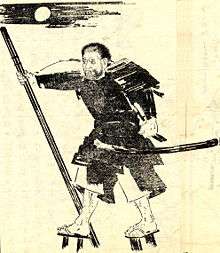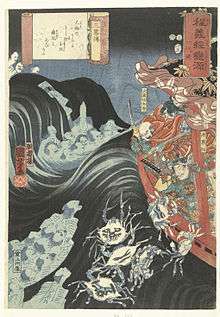Benkei
Saitō Musashibō Benkei (西塔武蔵坊弁慶, 1155–1189), popularly known as simply Benkei, was a Japanese warrior monk (sōhei) who lived in the latter years of the Heian Period (794–1185)[1]. Benkei led a varied life, first becoming a monk, then a mountain ascetic, and then a rogue warrior. He later came to respect and serve the famous warrior Minamoto no Yoshitsune. He is commonly depicted as a man of great strength and loyalty, and a popular subject of Japanese folklore, showcased in many ancient and modern literature and productions.

Early life


Stories about Benkei's birth vary considerably. One tells how his father was the head of a temple shrine who had raped his mother, the daughter of a blacksmith. Another sees him as the offspring of a temple god. Many give him the attributes of a demon, a monster child with wild hair and long teeth. In his youth, Benkei may have been called Oniwaka (鬼若)—"demon/ogre child", and there are many famous ukiyo-e works themed on Oniwakamaru and his adventures. He is said to have defeated 200 men in each battle he was personally involved in.
Benkei chose to join the monastic establishment at an early age and traveled widely among the Buddhist monasteries of Japan. During this period, monasteries were not only important centers of administration and culture, but also military powers in their own right, similar to the Roman Legions. Like many other monks, Benkei was likely trained in the use of the naginata, the half-moon spear.
At the age of seventeen, Benkei was said to have been 2 metres (6.6 ft) tall. At this point, he left the monasteries, and became a yamabushi, a member of a sect of mountain ascetics. Benkei was commonly depicted wearing a black cap that was a signature theme of such mountain ascetics.[1]
Seven weapons
Benkei armed himself with seven weapons, and is often depicted carrying these on his back. In addition to his sword, he carried a broad axe (masakari), a rake (kumade), a sickle (nagigama), a wooden mallet (hizuchi), a saw (nokogiri), an iron staff (tetsubō), and a Japanese glaive (naginata).[2]
Career

Benkei was said to have wandered around Kyoto every night on a personal quest to take 1000 swords from samurai warriors, who he believed were arrogant and unworthy. After collecting 999 swords through duels and looking for his final prize, he met a young man playing a flute at Gojotenjin Shrine in Kyoto. The much shorter man supposedly carried a gilded sword around his waist. Instead of dueling at the shrine itself, the two walked to Gojo Bridge in the city where the bigger Benkei ultimately lost to the smaller warrior, who happened to be Minamoto no Yoshitsune, a son of Minamoto no Yoshitomo. Some sources claim that the fight took place not at the Gojo Bridge, but instead at Matsubara Bridge.[3] Not long after the duel, Benkei, frustrated and looking for revenge, waited for Yoshitsune at the Buddhist temple of Kiyomizu, where he lost yet again.[4] Henceforth, he became Yoshitsune's retainer and fought with him in the Genpei War against the Taira clan.[5]
From 1185 until his death in 1189, Benkei accompanied Yoshitsune as an outlaw.[6]
Death
In the end, Benkei and Yoshitsune were encircled in the castle of Koromogawa no tate. As Yoshitsune retired to the inner keep of the castle to commit ritual suicide (seppuku) on his own, Benkei stood guard on the bridge in front of the main gate to protect Yoshitsune. It is said that the soldiers were afraid to cross the bridge to confront him, and all that did met swift death at the hands of the gigantic man, who killed in excess of 300 trained soldiers.
Realizing that close combat would mean suicide, the warriors following Minamoto no Yoritomo decided to shoot and kill Benkei with arrows instead. Long after the battle should have been over, the soldiers noticed that the arrow-riddled, wound-covered Benkei was still standing. When the soldiers dared to cross the bridge and take a closer look, the giant man fell to the ground, having died standing upright.[7] This is known as the "Standing Death of Benkei" (弁慶の立往生, Benkei no Tachi Ōjō). Benkei died at the age of 34.
Atago-do, now called Benkei-do, features a statue of Benkei six feet two inches in height in the posture he stood in when he died at Koromogawa. It was built in the era of Shotoku (1711–1716), replacing an older monument. In olden times the Benkei-do was at the foot of Chusonji hill until it was demolished. The ruins and a single pine tree still remain.[8]
In popular culture
Tales of Benkei's loyalty and honour have made him a mainstay of Japanese folklore, as well as a popular subject for literature and entertainment.
One kabuki play places Benkei in a moral dilemma, caught between lying and protecting his lord in order to cross a bridge. The critical moment of the drama is its climax, where the monk realises his situation and vows to do what he must. In another play, Benkei slays his own child to save the daughter of a lord. In the Noh play Ataka, Benkei must beat his own master (disguised as a porter) in order to avoid breaking his disguise. Ataka was later adapted into the kabuki play Kanjinchō, which became one of the most popular and widely performed works in Japanese theatre.
Film and television
- A silent, black and white film adaptation of Benkei's story, simply titled Benkei, was released in 1912.[9]
- Denjirō Ōkōchi portrays Benkei in Akira Kurosawa's 1945 film The Men Who Tread on the Tiger's Tail, based on Kanjinchō.[10]
- The characters Benkei Kuruma and Benkei Musashibo from the Getter Robo franchise are both named for Benkei.
- In the tokusatsu series Choujinki Metalder, Ben-K is a human antagonist, one of the many "villain-of-the-week" characters that Metalder encounters throughout the series. Like the folkloric Benkei, Ben-K is torn between his loyalty to the main villain Neros, and the life with which he had previously become disillusioned.
- Daisuke Ryu portrays Benkei in Sogo Ishii's 2001 historical fantasy film Gojoe: Spirit War Chronicle.
- Ken Matsudaira portrays Benkei in the 44th Taiga Drama, Yoshitsune.
- In the manga and anime series One Piece, there is an Ushi-oni-themed warrior monk and highwayman named Gyukimaru who resides in the country of Wano, which is based on Feudal Japan. Like Benkei, he is depicted as an expert in using the naginata and steals weapons from samurai he believed arrogant and unworthy. The duel at the Gojo Bridge was also re-enacted between him and Roronoa Zoro, a member of the Straw Hat Pirates. Aside from Gyukimaru, there are also a number of other characters who share Benkei's attributes. These include Edward Newgate (Whitebeard) of the Whitebeard Pirates and the Four Emperors who wielded a naginata and died standing,[11] and Big Mom Pirates (also of the Four Emperors) commander Charlotte Katakuri, who never fell on his back prior to his battle against the protagonist Monkey D. Luffy.[12]
- Benkei is a secondary character in the manga and anime Kurozuka.
- In Kamen Rider Ghost, the "Benkei Damashii" transformation is themed after the historical Benkei.
Video games
- Benkei appears in the Goemon video game series, which are set in a parody of feudal Japan. In Mystical Ninja Starring Goemon, Benkei guards the Gojo Ohashi Bridge in Zazen Town. He refuses to let you pass until he's defeated with the help of Ushiwaka, a reference to his defeat by Minamoto no Yoshitsune.
- In the video game Brave Fencer Musashi, one of the minor antagonists is named Ben, who is part of a trio named "Leader's Force", serving as the team's muscle. He is often seen alongside Ed. Musashi first meets the two at the bottom of the well, where they hid a church bell they themselves stole with the intention of selling it. When Musashi returns the bell to its rightful place, the duo vow revenge, burning the village. Ben is encountered again in the final chapter of the game, where he fights Musashi. When he is defeated, he appears to allow Musashi to pass, although his lack of response implies that he most likely died standing, much like Benkei.
- Benkei and Yoshitsune are the protagonists of the 2005 video game Genji: Dawn of the Samurai and its 2006 sequel, Genji: Days of the Blade.
- Benkei is a playable character in the Warriors Orochi series of video games.
- In the game Pokemon Black and White 2, an elderly trainer in Village Bridge stated he had 999 winning streak in Pokemon battle and challenges the player, referencing the historical Benkei's streak.
- Benkei was meant to appear in Fate/Apocrypha as a Lancer-class Servant but later scrapped along with Sakata Kintoki, Saint George and King David. He and the other three were later properly introduced in Fate/Grand Order.
- Benkei appears in the video game Nioh, as a phantom-boss that you fight on a bridge. The bridge references Benkeis last stand against enemy samurai.
- Benkei appears again in the video game Nioh 2, where he fights the player and, upon being defeated, aids them in finding Yoshitsune.
Notes
- Yoshikawa, Eiji (1956). The Heike Story: A Modern Translation of the Classic Tale of Love and War. New York: New York: Alfred A. Knopf. ISBN 978-0-8048-1376-1.
- Ashkenazi, Michael (2003). Handbook of Japanese Mythology. Santa Barbara, CA: ABC-CLIO. pp. 124–125. ISBN 978-1576074671.
- Matsumoto; Nasu, Kana; Satoku (June 29, 2012). "The Legend of Yoshitsune Minamoto". The Kyoto Project. The Kyoto university of Foreign Studies.
- Matsumoto; Nasu, Kana; Satoko (June 29, 2012). "The Legend of Yoshitsune Minamoto". The Kyoto Project.
- Kitagawa, Hiroshi et al. (1975). The Tale of the Heike, pp. 535, 540, 654, 656, 669.
- Sansom, George (1958). A History of Japan to 1334. Stanford University Press. pp. 317, 326. ISBN 978-0804705233.
- Turnbull, Stephen (1977). The Samurai, A Military History. MacMillan Publishing Co., Inc. p. 83. ISBN 978-0026205405.
- De Benneville, James S (1910). Saito Musashi-bo Benkei : tales of the wars of the Gempei, being the story of the lives and adventures of Iyo-no-Kami Minamoto Kuro Yoshitsune and Saito Musashi-bo Benkei the warrior monk. Yokohama: Yokohama: J.S. De Benneville. p. 444.
- Benkei, 1912, retrieved 2018-04-18
- Kurosawa, Akira (1960-02-28), The Men Who Tread on the Tiger's Tail, Denjirô Ôkôchi, Susumu Fujita, Ken'ichi Enomoto, retrieved 2018-04-18
- Oda, Eiichiro (2010). One Piece Vol. 59, Ch. 576. Japan, Shueisha. ISBN 978-4-08-870083-0
- Oda, Eiichiro (2018). One Piece Vol. 89, Ch. 896. Japan, Shueisha. ISBN 978-4-08-881496-4
References
- Ribner, Susan, Richard Chin and Melanie Gaines Arwin. (1978). The Martial Arts. New York: Harper & Row. ISBN 0-06-024999-4.
- Kitagawa, Hiroshi and Bruce T. Tsuchida. (1975). The Tale of the Heike. Tokyo: University of Tokyo Press. ISBN 0-86008-189-3.
- Yoshikawa, Eiji. (1956). The Heike Story: A Modern Translation of the Classic Tale of Love and War. New York: Alfred A. Knopf. ASIN B0007BR0W8 (cloth).
- _____. (1981). The Heike Story: A Modern Translation of the Classic Tale of Love and War. Tokyo: Tuttle Publishing. ISBN 0-8048-1376-0 (paper).
- _____. (2002). The Heike Story: A Modern Translation of the Classic Tale of Love and War. Tokyo: Tuttle Publishing. ISBN 0-8048-3318-4 (paper).
- (in Japanese) _____. (1989) Yoshikawa Eiji Rekishi Jidai Bunko (Eiji Yoshikawa's Historical Fiction), Vols. 47–62 Shin Heike monogatari (新平家物語). Tokyo: Kodansha. ISBN 4-06-196577-8.
External links
| Wikimedia Commons has media related to Benkei. |
- Grunwald Center for the Graphic Arts, UCLA Hammer Museum: woodcut print – "Ushiwaka and Benki duelling on Gojo Bridge" or "Gojo Bridge, an episode from the Life of Yoshitsune, Chronicles of Yoshitsune" by Tsukioka Yoshitoshi (1839–1892)